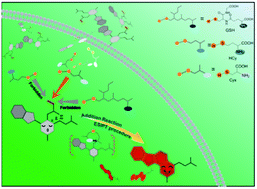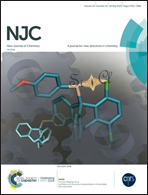ESIPT-based fluorescent probe for cysteine sensing with large Stokes shift over homocysteine and glutathione and its application in living cells†
Abstract
Cysteine (Cys) is an important amino acid containing a sulfhydryl group, and it is involved in cellular growth and an abnormal level of Cys in vivo is suggestive of many diseases. Hence, development of fluorescent probes for intracellular Cys detection and imaging is of pivotal importance. So far, a number of fluorescent probes have been developed for Cys detection successfully. However, many of them could hardly discriminate Cys from Hcy, GSH or other reactive sulfur species (RSSs) and the emission wavelength of the probes is mainly located in the ultraviolet/short wavelength region with small Stokes shifts (<100 nm). Herein, based on the impressive fluorescence properties of the ESIPT process, a new fluorescent probe named ABT-MVK is synthesized and used to detect Cys. This probe utilizes a typical ESIPT dye (HBT) as the fluorophore and an acrylate group as the ESIPT blocking agent as well as a recognition unit. Cleavage of the acrylate moiety can be achieved by Cys rapidly and specifically in aqueous buffer, which restores the ESIPT process and endows the probe with a “Turn ON” fluorescence detection feature with a large Stokes shift (ca. 225 nm) for Cys with superior selectivity over various potential interferents, including Hcy, GSH, Na2S or NaHSO3. The detection limit for Cys was calculated to be as low as 19 nM and intracellular bio-imaging of Cys by this probe was successfully applied in living cells, indicative of great potential for biological applications.



 Please wait while we load your content...
Please wait while we load your content...